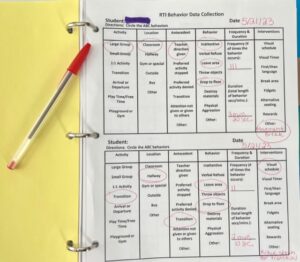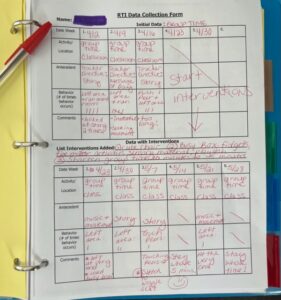
Let’s talk about RTI or Response To Intervention!
Last year I started a new special education position where I go into pre-k classrooms and service students with IEPs and students who are needing RTI. Most of the students in the classroom were not yet identified with a disability and did not have an IEP, but also struggled significantly to function in the general education classroom. Our district requires at least 6 weeks of intervention and data before having a problem-solving meeting. This can be very frustrating for the teachers and the student who may need interventions immediately. Many of the students I worked with this past school year were not able to function within the general education classroom without intensive interventions. To be honest this drove me crazy, especially since I have taught self-contained preschool previously for 20 years. Over the course of the year, I had to change my mindset from IEP to RTI.
I have been using a variety of data forms to help me determine:
-
- If my student needs to go to problem solving by tracking behaviors
-
- What interventions they need and which ones work for them
-
- Track behaviors and interventions over time to determine if an evaluation for an IEP may be needed
I’ve switched my data forms frequently over the school year to see which I like better and which my teachers felt were easy to use. We both filled out the forms either together or separately, but would discuss our results at the end of the day or week.
I also have tried lots of different interventions to help my kiddos in the general education classroom. Here is a list that I made that you may find useful:
If you are looking for more specific data collection forms that I have used, you can check out my data collection forms on TPT. See link below:


RTI data can help you identify what interventions are working, the frequency/duration of a specific behavior, if your student may need further evaluation, and track your student’s progress. It is important to have data to support your student’s needs and to provide evidence that your student may need more support. It’s a difficult process, but can be so beneficial to our students.



